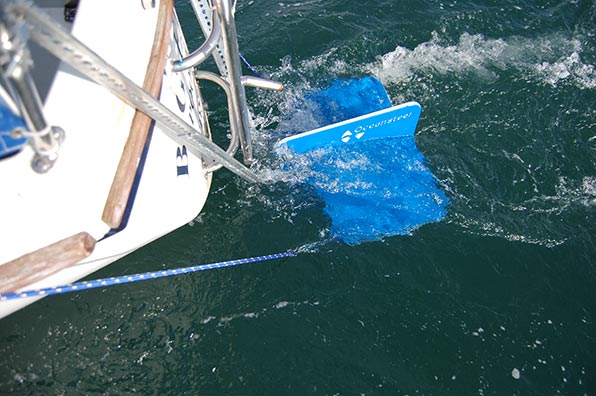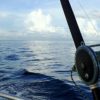Do you have a backup steering plan?
In spite of the issues that we had, and my initial fears, I don’t think there’s much risk of us losing our rudder. In the research that I have done, I haven’t found any reports of an Amel’s skeg-hung rudder falling off. Of course, anything could happen (whale???), which is why having an alternate method of steering, or at least a plan on how to make it work, seems to be prudent.
I’ve read in several places that some sort of drag device, either a purpose-built drogue or an improvised one, can be used to steer the boat in an emergency. With one towed behind the vessel on a bridle, with lines led to cockpit winches, the boat can be turned to starboard by trimming in the starboard line and easing its counterpart. The opposite would be done to turn the boat to port. Of course, this is all theory for me as I’ve never actually tried it. Have you?
I recently came across a link for a product called Oceansteer, marketed as an emergency steering system for yachts. It looks pretty good.

In unrelated news, I just read this in my morning weather email:
“Confidence is high that Patricia will make landfall along the coast of SW MX as an extremely dangerous cat 5 hurricane this afternoon or evening. Catastrophic storm surge possible near & to the E of where the center makes landfall. Patricia is currently 169 miles SSW of Manzanillo, moving NNW. It has HHs measured winds of 200mph & a central pressure of 880mb. Patricia is the strongest eastern N Pacific hurricane on record – and is going to be awful trouble for MX – a beautiful part of the country that I spent considerable time at in years gone by.”
Not good!




I don’t have a solid plan in case of rudder loss – just a lot of ideas. The Oceansteer product looks interesting, but there sure seems to be little info on their website.
I wonder how it would work in larger seas where there is lots of pitching. It’s looks pretty shallow. I hope they address that problem.
I’m guessing that it would be fairly easy to build one of these yourself, which may be why there is very little info.
Thanks for the link. It will add more options for planning for a situation that none of us want to be in.
Options are good.
That weather will be hitting us this weekend in San Antonio. Predictions range from 4 inches up to 17.
Need to make a run to the store….beer and wine!
Better get some food too. I recommend potato chips.
I remember learning how to steer with just the sails in the US Sailing Keelboat class. Mostly I remember it was a lot harder than the instructor suggested it would be and I suspect it would be incredibly tiring to do for any length of time.
Under ideal circumstances the boat will be balanced and near sail itself. I’m betting that doesn’t happen often.
Funny you should ask. I hit a submerged tree 4 days ago at 8 knots in mid-Chesapeake. I was alone and suddenly the wheel would not turn.
* Checked for water in the port aft crash tank. Dry.
* Main down, genoa reefed. This kept her crawling down wind, and I had some room.
* Cleaned out the aft locker fast, crawled in and disconnected the cross bar. A little bumpy (20 knots) but really easy to do it turns out.
* Cruised for 2 more days. Steering was sluggish, but so long as the sails were balanced the auto pilot still worked fine.
Tomorrow I’m going to try to un-bend it with a chain fall. We’ll see.
—-
If you only have one rudder a back-up plan is smart. I would certainly take the SeaBrake off the PDQ. It might be about the right size for this, for the Amel.
Leave it to you. 🙂
I sold the Seabrake a couple of years ago. We found a similar drogue on the Amel though. That is what I would use as a drag device if forced into it.
Our Hydrovane can easily steer the boat as a tiller – built in emergency rudder. Great secondary use feature!
My real concern would be if our primary rudder were jammed somehow, unfixably, to one side. Our primary (skeg hung) rudder is a huge barn door and if it were hard over, even with the vane and drag devices I worry how well we could steer.
Yeah, that would be a problem.
My understanding is that when you hit something, it is straight and many plans work. If you jam it getting thrown backwards (heaved to, for example, or bad breaking waves) it will be hard over and nothing is going to work.
I will repeat my pitch for the dry suit. I went for a swim to survey the damage, once I found shelter and was anchored. With a dry suit it was casual, and then I went kayaking. Without, oh dear (50F water, getting colder). However, I am going to buy a hood and some better gloves, I think.
There has been some discussion regarding whether dry suits can substitute for immersion suits for cruisers. Certainly they have far more uses. I’ve used mine as foul weather gear in cold weather (anything below 55F), when I already had it on from kayaking or something, and I found I forgot I was wearing it (as opposed to foul weather gear). I should add that mine is a hybrid type with built in jacket, hood, and increased venting. I’ve looked at the CG regulations for immersion suits (46 CFR 160.171) and to my eye, a dry suit compares favorably if just a few compensation are made (wear a PFD, shoes, gloves, hood, have one fitted for each crew member. Certainly it would be the better bet in a life raft or extreme sailing situation (full agility).
They’re on the list. Unfortunately, it’s a very long list.
When I was a kid and we were bringing our boat all the way from Lake Michigan to Grenada we lost our steering after leaving St. Thomas on our way to Grenada. We steered by sail, which required a ton of sail repair, and built a rudder out of stuff we had on the boat. Chris Doyle was our hired skipper since my parents were new to ocean sailing and he wrote an article for Caribbean Compass last year that you might find interesting. Here is the link…it starts on page 25.
http://www.caribbeancompass.com/online/october14compass_online.pdf
Interestingly enough Don Street wrote an article on the same topic on page 23 of this same edition. Don was a good family friend when he lived with his 3 children on Iolaire in Prickly Bay where we also lived on Traumerei. Man do I miss those days and our simple life.
Chris Doyle was your skipper? I think you were in good hands.
Ha, we taught him everything he knows! J.K. It was 40 something years ago though. Wow, that makes me feel really old!
🙂